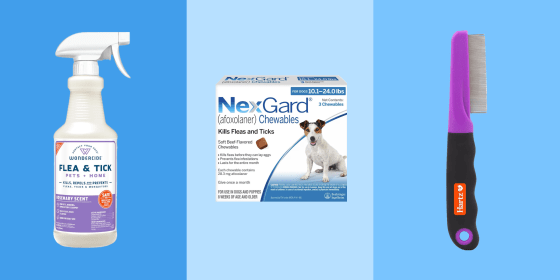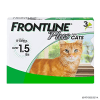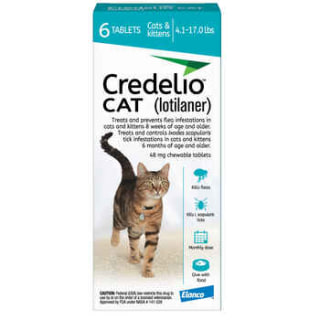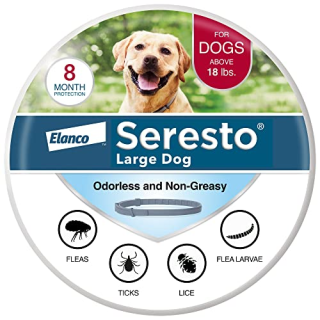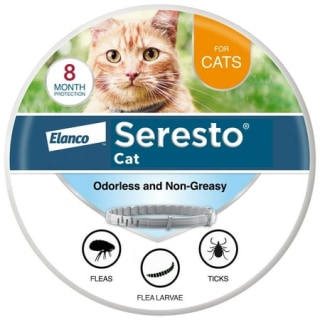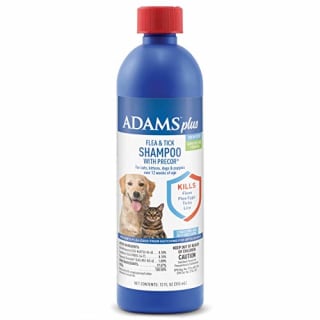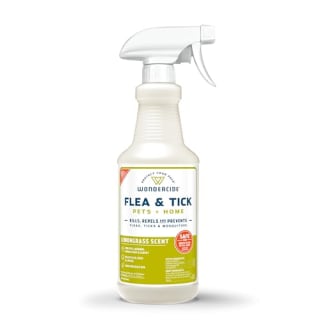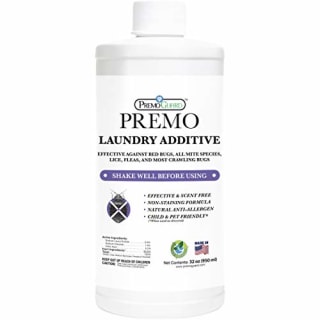We don’t always have the answers, but we have some people on speed dial who do — which is why we present to you our FYI series where we have experts explain if lip balm is actually bad, how often you should wash your hair and more.
They’re the four words you never want to hear: your pet has fleas. The tiny bugs make cats and dogs uncomfortable, and once they’re in your home, they’re very hard to get rid of. But don’t panic — you can take steps to quickly tackle the problem and use effective products along the way.
I spoke to veterinarians about how to get rid of fleas on your pet and in your home. Vets also explain the health risks fleas pose, and why they recommend giving cats and dogs preventative medication year round.
SKIP AHEAD Diagnosing your pet with fleas | Treatment and prevention | Cleaning your home
How to get rid of fleas
There are four main steps involved in getting rid of fleas: Diagnosis, treatment and prevention, and cleaning. It’s crucial to carry out each one and not rush the overall process — if you cut corners, you put your pet at risk for reinfection and your home at risk for repeated infestation, says Dr. Katy Nelson, a senior veterinarian at Chewy. (Ed’s note: The inclusion of products sold by Chewy in this article was made independently of Nelson.)
As you move through each step outlined below, regularly update your veterinarian. They’re the expert when it comes to your pet’s health and can make recommendations as needed. Also remember that diagnosing your pet with fleas can require a trip to the vet, so don’t hesitate to make an appointment.
Step 1: Diagnose your pet with fleas
While fleas are tiny bugs, you can see them with the naked eye, especially in cats with light skin or fur, says Nelson. They’re usually smaller than a grain of rice (one to three millimeters in length), have a flat body and are brown to reddish-brown in color. But seeing fleas on your pet or in your home isn’t always a guarantee, so it’s important to know what other signs to look for.
Signs of fleas in pets
- Increased itching: Flea bites are sharp and painful, and their salivary glands give off a substance that’s irritating to pets. Some are even allergic to it. In response, your cat or dog may be more itchy than usual — and we’re not talking about casual scratching. Pets with fleas tend to aggressively and consistently itch different parts of their body, so much so that they can create a rash, says Dr. Mitzi D. Clark, a veterinarian and assistant clinical professor at Cornell University’s College of Veterinary Medicine.
- Excessive grooming: Think constant licking and biting at skin, which is most common with cats, says Clark. “Cats are fastidious groomers and will often lick or chew off any fleas they find,” she says. If you notice your cat overgrooming, run your fingers through their hair and look for small, crusty bumps on their skin, as well as hair loss, especially toward the base of the tail and the behind.
- Presence of flea dirt: Fleas move quickly through your pets’ fur, so it’s usually easier to look for flea dirt, which is flea feces. It looks like black pepper, says Nelson. You’ll find black specks on your pet’s coat, as well as anywhere they sit, like on a bed or in a cat tree.
- Flea bites on your body: Yes, fleas can bite you, too. They prefer pets to humans, but if they can’t access a pet, they tend to bite humans’ legs, feet and ankles, though you can get bit anywhere. On human skin, flea bites look like little red dots. They’re usually surrounded by redness and can appear in clusters, experts told me.
- Fleas on hair follicles: If you’re lucky, you’ll see a flea on your pet, which gives you a definitive diagnosis. “If you see one flea, it’s like the tip of the iceberg,” says Dr. Douglas Kratt, a small-animal practitioner at Central Animal Hospital in Wisconsin. “One flea can lay thousands of eggs in a fairly short period of time.”
Best flea comb: Hartz Groomer’s Best Flea Comb
A flea comb is your best friend when it comes to diagnosing fleas. The fine-toothed comb helps you part your pet’s fur to better see their skin and hair follicles, which may reveal fleas or flea dirt.
This comb is designed to remove fleas, flea eggs and other debris like flea dirt from pets’ hair. It’s suitable for dogs and cats, and it doubles as a grooming tool that detangles knots. The comb’s ergonomic handle makes it easy to grip and control. It has a 4.7-star average rating from 21,724 reviews on Amazon.
How to properly use a flea comb
- Use the comb to part your pet’s hair down the middle of their back. Look closely — you may see fleas scurrying away, says Nelson. Also run the comb through hair on your pet’s face, neck and the base of their tail, which are areas that fleas commonly gather. Check thinly furred areas like the belly and groin, too.
- If you don’t see any fleas, look for flea dirt. Not sure if what you’re seeing is flea dirt or regular dirt? Use the flea comb to gather up the pepper-looking substance, put some on a white paper towel and spray it with water. “Wet flea dirt will turn red or reddish-brown as it is basically digested blood,” says Nelson.
- While combing your pet’s fur, keep a bowl of soapy water or isopropyl alcohol next to you. Clean your comb off in it and dispose of fleas you find into it. Fleas get trapped in the liquid, which prevents them from jumping back onto you or your pet. Then, pour the flea-filled liquid down the drain, says Kratt.
Step 2: Treatment and prevention
Once your pet is diagnosed with fleas, immediately start treating them and preventing future infestations. Luckily, you can do both at the same time. Some oral and topical medications, as well as medicated collars, simultaneously kill and repel fleas to stop another outbreak from occurring. Many of these products also protect pets against other parasites, like ticks, lice, biting flies and mosquitos.
Kratt says there are dozens of options available, and choosing the right one involves considering factors like their species, breed, size, age, health conditions, lifestyle and home environment, as well as any medications they may be taking. Because of this, it’s important to consult your vet.
There are a few rules to follow when shopping for, and administering, flea preventatives.
- Buy a product that aligns with what type of pet you have. Never give your cat something that’s specifically formulated for dogs, or vice versa, says Nelson. Although, some products may be safe for both species.
- Always match a flea product to your pet’s age and size. Many are labeled with a weight range and tell you what ages it’s safe for. Exercise extra caution with very old and very young pets, as well as those that are pregnant and/or nursing.
- Look for EPA- and FDA- approval statements: Some flea products are regulated by the Environmental Protection Agency, while others are regulated by the U.S. Food and Drug Administration. Medications and pesticides must meet U.S. government-required safety standards before they’re sold, so look for an EPA or FDA approval statement and number somewhere on products’ packaging.
- Pay attention to active ingredients: Broad-spectrum flea products are typically made with two types of active ingredients: insecticides, which kill adult fleas, and insect growth regulators, which stop the development of flea eggs and larvae. The exact active ingredients used depend on the product and the type of pet it’s for — ingredient labels typically list all this information.
- Follow the directions and dosage recommendations exactly as listed on the product’s packaging.
- Check the expiration date on a product’s packaging before using it. If it’s expired, throw it out. The active ingredients in flea products lose their potency over time, so anything that’s expired may be ineffective, says Nelson.
Below, I break down the most common types of flea prevention treatments for dogs and cats with examples of options that meet expert guidance. All the products I recommend are highly-rated, act as preventatives and treatments, and protect against multiple types of parasites. While a handful of flea products are sold over-the-counter, many are only available via a prescription, which is another reason why it’s so important to talk to your vet.
Oral medications
Oral flea medications come as treat-like chews and pills. Your pet ingests the oral medication, which is made with chemicals that get transmitted to fleas when they bite skin, thus killing them.
Best flea chews for dogs: NexGard Chewables
Mili Godio, NBC Select updates editor, started giving Bella, her now 6-year old, 15-pound havachon, these beef-flavored chews when she was four months old. “Bella is constantly running outside and going to dog parks, and I’ve never had a flea problem,” says Godio. “I love that these chews are so easy to give her every month. I act like they’re a treat, so she actually gets excited to eat them.” NexGard’s bite-sized chews are FDA-approved to kill adult fleas before they can lay eggs, as well as kill black-legged ticks. (This flea chew requires a prescription from your veterinarian, which the online retailer you purchase from will collect at checkout.)
Active ingredients: Afoxolaner | Starts working within: 4 hours | Lasts for: 1 month | Dosage options: 4 to 10 pounds, 10.1 to 24 pounds, 24.1 to 60 pounds, 60.1 to 121 pounds | Age minimum: 8 wks. | Weight minimum: 4 lbs.
Best flea chews for cats: Credelio Cat
Credelio’s chews kill fleas and black-legged ticks, and you have to give them to your pet with food. The chews, which have a 4.5-star average rating from 406 reviews at Chewy, are small in size so they’re easy for cats to eat. They’re also made with yeast and vanilla to give them an appealing taste. (This flea chew requires a prescription from your veterinarian, which the online retailer you purchase from will collect at checkout.)
Active ingredients: Lotilaner | Starts working within: 6 hours | Lasts for: 1 month | Dosage options: 2 to 4 pounds, 4.1 to 17 pounds | Age minimum: 8 wks. | Weight minimum: 2 lbs.
Topical medications
Topical flea medications, which are also called spot on medications, are sold as pre-dosed liquid solutions you apply to pets’ skin. It typically goes between their shoulder blades or along the spine so they can’t lick it off. Some topicals work by spreading through pets’ hair and the skin’s natural body oils — in this case, fleas die upon contact with your pet’s coat. Other topicals are absorbed by the skin and circulate through the bloodstream — in this case, fleas die when they bite your pet.
If you only have one pet in your household, flea topicals are a great option. But they’re tricky to use in multi-pet households. These medications cannot be ingested by pets, so vets recommend against using them if you have multiple cats that frequently groom each other. It’s also not a great idea to use flea topicals if you have cats and dogs in your household. Some chemicals in dog flea topicals are toxic to cats, so avoiding them is the safest option.
Best flea topical for dogs: Frontline Plus Flea and Tick Treatment for Dogs
Frontline Plus’ unscented topical solution kills adult fleas, flea eggs and flea larvae, as well as chewing lice and ticks. It’s available in packs of three, six or eight treatments. The solution comes in pre-measured applicators.
Active ingredients: Fipronil, (S)-methoprene | Starts working within: 24 hours | Lasts for: 30 days | Dosage options: 5 to 22 pounds, 23 to 44 pounds, 45 to 88 pounds, 89 to 132 pounds | Age minimum: 8 wks. | Weight minimum: 5 lbs.
Best flea topical for cats: Frontline Plus Flea and Tick Treatment for Cats
Frontline Plus also offers an unscented topical solution for cats. It kills adult fleas, flea eggs and flea larvae, as well as ticks and chewing lice. The solution comes in pre-measured applications, and it’s available in packs of three, six, eight or 12 treatments.
Active ingredients: Fipronil, (S)-methoprene | Starts working within: 12 hours | Lasts for: 30 days | Dosage options: Over 1.5 lbs. | Age minimum: 8 wks. | Weight minimum: 1.5 lbs.
Flea collars
Flea collars sit around your pet’s neck and are infused with chemicals that kill and repel the pests. Over time, your pet’s hair and skin absorbs the chemicals and distributes them across the body. Because of this, flea collars work through contact, meaning fleas don’t have to bite your pet in order to die. But you have to keep the flea collar on your pet at all times for it to work.
One of the most important factors to consider while shopping for a flea collar is whether it’s designed with a mechanism that unclasps if your pet gets it caught on something, says Kratt. If it’s not, it can become a choking hazard.
Best flea collars for dogs: Seresto Dog Flea Collar
Seresto’s dog collar protects against fleas and flea larvae, as well as ticks and lice. The non-greasy, odorless collar is designed with a safety release mechanism that allows it to widen and break off pets’ necks if pulled hard enough.
Active ingredients: Imidacloprid, flumethrin | Starts working within: 24 hours | Lasts for: 8 months | Dosage options: Under 18 lbs, over 18 lbs. | Age minimum: 7 wks. | Weight minimum: N/A
Best flea collars for cats: Seresto Cat Flea Collar
Seresto’s cat collar protects against fleas, flea larvae and ticks. The collar is designed with a safety release mechanism that allows it to widen and break off pets’ necks if pulled hard enough.
Active ingredients: Imidacloprid, flumethrin | Starts working within: 24 hours | Lasts for: 8 months | Dosage options: One size | Age minimum: 10 wks. | Weight minimum: N/A
Are flea shampoos effective?
“Flea shampoos work to temporarily decontaminate the surface of your pet, but they don’t offer protection,” says Kratt. “They will help get rid of flea dirt, but some of the chemicals used in flea shampoos can be irritating to pets’ skin.” Because of that, you shouldn’t use flea shampoo long-term.
Best flea shampoo: Adams Plus Flea & Tick Shampoo
This flea shampoo is made with ingredients that help it kill adult fleas, flea eggs, flea larvae, ticks and lice. It also has soothing aloe vera, lanolin, coconut extract and oatmeal in its formula to make it gentle on sensitive skin. The lightly scented flea shampoo leaves your pet’s coat shiny and soft. You only need to use about 1 ⅓ tablespoons for every five pounds of your pet’s weight, and the brand recommends waiting about seven to 10 days between repeat shampoos, if necessary. Be sure not to get this product near your pets’ eyes.
Active ingredients: Pyrethrins, S-Methoprene, piperonyl butoxide | Starts working within: Upon contact | Lasts for: 28 days | Dosage options: N/A | Age minimum: 12 wks. | Weight minimum: N/A
Step 3: Clean your home
Deep cleaning your home is a crucial part of the flea removal process, and it’s no small feat. The flea life cycle is 30 days long, so any eggs in your home will hatch in stages, says Nelson. That means it might take a few months until your space is completely flea-free.
You can use products like those listed below to clean your home, but you may want to consider professional extermination. Flea eggs are very hard to kill, and if you don’t clean your home thoroughly enough, you put yourself, your pet and your space at risk of reinfestation. Just keep in mind that exterminators typically use very strong chemicals to get rid of fleas — since they’re often toxic to people and pets, you and your furry friends will have to vacate your home for a few days.
Here are expert tips for cleaning your home while dealing with a flea problem, and products to help you do so. Regardless of what cleaners you use, be sure to follow the directions exactly as listed and ventilate rooms well while you’re disinfecting them, says Nelson. Also keep your pets away from areas you’re treating — some brands may even tell you to leave rooms for a specified period of time after applying their cleaning products.
Best flea spray: Wondercide Natural Flea, Tick and Mosquito Spray
Cleaning is a whole-home operation when it comes to fleas, says Kratt. With that in mind, a spray like this one comes in handy. You can use it on carpets, rugs, pet beds and furniture cushions, which are all areas you’ll need to disinfect. “Flea larvae hatch from eggs and then burrow deep into carpets and crevices in furniture where they are hard to access,” says Nelson. She specifically recommends spraying the underside of rugs and cushions, which are common areas people miss. Don’t forget about hard surfaces, too, like baseboards and tile, wood or laminate floors. “If there’s crevices, eggs and fleas can get inside,” says Kratt.
Wondercide’s spray, which has a 4.2-star average rating from 33,823 reviews on Amazon, takes a natural approach to getting rid of fleas. Instead of hard chemicals, it uses plant-based ingredients to kill fleas, flea eggs and flea larvae upon contact, as well as repel and prevent them, according to the brand. The pet- and people-safe spray also works on ticks and mosquitoes. It’s available in scents like lemongrass, cedarwood, peppermint and rosemary, and four sizes: four ounces, 16 ounces, 32 ounces and one gallon.
Active ingredients: Sodium lauryl sulfate, cedarwood oil, lemongrass oil and sesame oil | Starts working within: Upon contact | Lasts for: Not specified
Best carpet powder for fleas: PetArmor Home Carpet Powder for Fleas and Ticks
Thoroughly vacuuming carpets, rugs and upholstery is a must since fleas burrow into fabric. Before doing so, you can spot-treat areas with this powder. It kills flea eggs, larvae and pupae, as well as adult fleas and brown dog ticks. The powder, which has a 4.2-star average rating from 13,824 reviews on Amazon, also deodorizes carpets to get rid of pet odors. It starts working within an hour of application, but the brand recommends waiting 24 hours before vacuuming.
After you vacuum, make sure you thoroughly clean the appliance to prevent flea eggs and larvae from surviving inside it. If they do, they can reinfect your home. “If your vacuum cleaner has a bag, you must take it outside to the garbage can immediately and tie it up,” says Kratt. “If your vacuum is bagless, you must empty it and spray the internal portion of your canister with a cleanser.”
Active ingredients: Pyriproxyfen, pyrethrins, N-octyl bicycloheptene dicarboximide | Starts working within: 60 mins. | Lasts for: 12 months
Best laundry detergent for fleas: Premo Laundry Additive
“Any bedding, towels, toy or other washable objects your pet regularly comes in contact with should be washed in soapy hot water and dried in a hot dryer,” says Nelson. Standard laundry detergent works well, but this scent-free solution is made with ingredients that effectively get rid of fleas to give you extra peace of mind. It also helps eliminate parasites like bed bugs, lice, ticks and mites. You can use the solution with or without laundry detergent, and it’s available in two sizes: 32 ounces and one gallon.
Active ingredients: Sodium lauryl sulfate, sodium chloride, citric acid | Starts working within: N/A | Lasts for: N/A
Meet our experts
At NBC Select, we work with experts who have specialized knowledge and authority based on relevant training and/or experience. We also take steps to ensure that all expert advice and recommendations are made independently and with no undisclosed financial conflicts of interest.
- Dr. Katy Nelson is a senior veterinarian at Chewy. (Ed’s note: The inclusion of products sold by Chewy in this article was made independently of Nelson.)
- Dr. Mitzi D. Clark is a veterinarian and assistant clinical professor at Cornell University’s College of Veterinary Medicine. She’s an expert in veterinary dermatology.
- Dr. Douglas Kratt is a small-animal practitioner at Central Animal Hospital in Wisconsin.
Why trust NBC Select?
I’m an associate updates editor at NBC Select who writes about pets, including articles on kitten food, dog beds, cat toys, dog sunscreen and cat travel carriers. For this article, I interviewed three veterinarians about how to get rid of fleas and rounded up products that meet experts’ guidance.
Catch up on NBC Select’s in-depth coverage of personal finance, tech and tools, wellness and more, and follow us on Facebook, Instagram, Twitter and TikTok to stay up to date.
